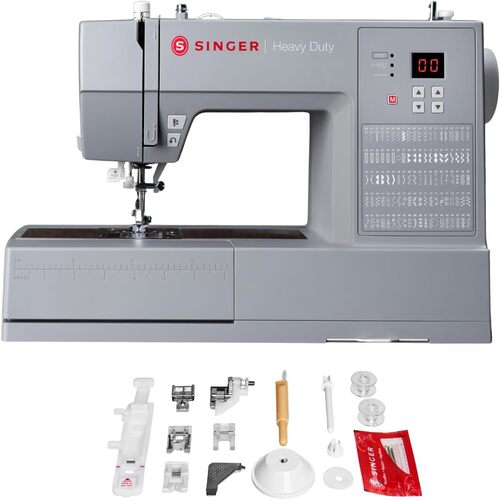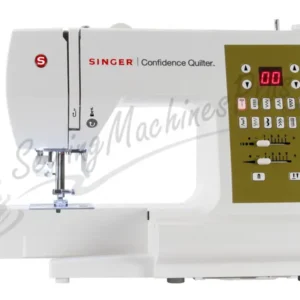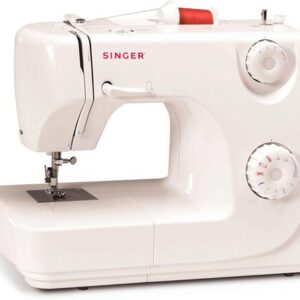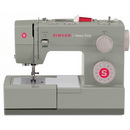
I still remember the thud on my doorstep the morning the Singer 6620C arrived. For weeks I’d been sifting through Singer 6620C reviews, trying to figure out if this “heavy duty, computerized” thing was perfect for me or total overkill. My old basic machine was on its last leg, and I wanted something that could handle everyday mending plus the occasional denim, canvas, and small quilting projects. I was excited — and a little scared I’d bought too much machine.
Unboxing jitters → calm
When I slid the Styrofoam aside, the first thing I noticed was how solid the machine felt. Not brick-heavy, but steady in a way that promised less wobble on the table. The grey body looked clean and purposeful, with a simple screen and a few buttons that actually made sense at a glance. The accessory tray had the practical stuff I use most — presser feet, bobbins, needles — and I added my own extension table because I knew I’d want more support for quilts and totes.
Threading was the moment of truth. I’m not exactly a gadget person, but the path is clearly marked, and the built-in needle threader did its thing without a fight. Two tries, and I was through the eye. I pressed the Start/Stop button (my hands still hovering, ready to yank the fabric away) and eased the speed slider all the way down. The motor didn’t rattle or whine; it just hummed. That quiet confidence instantly calmed mine.
First project: a tote that didn’t look “homemade”
I grabbed cotton canvas and webbing to make a market tote. The straight stitch looked crisp right away — no tight loops on top, no loose spaghetti on the bottom. The LED lighting actually let me see the seam allowance without leaning over like a detective with a magnifying glass. When I hit reverse to lock the seam, the machine responded smoothly. Simple, but it felt professional.
At the thick strap joins, I switched to a 90/14 jeans needle and went slow. The Singer 6620C heavy duty motor climbed the little “speed bumps” without drama. No clunks, no needle bending. I can’t pretend it felt like an industrial machine, but for a home model, it handled those layers better than I expected.
The “fun stuff” I didn’t know I’d use
Once I relaxed, I started playing. The machine’s computerized side is friendly: pick a stitch, tweak length or width, and the screen reminds you which foot belongs on the machine so you don’t guess wrong. Decorative stitches gave my table runner a quick glow-up, and the one-step buttonhole was a lifesaver on a linen shirt (I made three test buttonholes on scraps, and all of them looked neat).
I hemmed two pairs of jeans the same afternoon. With the speed slider set mid-range, my stitches looked even, and the needle up/down button made pivoting around bulky hems easy. I also tried a stretchy knit cuff using one of the stretch stitches — no tunneling, no bird’s nest. That was a happy surprise.
Where “heavy duty” helps — and where it doesn’t
Because I’d read so many Singer 6620C reviews before buying, I wanted to see what the machine really could handle. I layered denim with cotton and some faux leather trim. If I kept the right needle in (again, 90/14 or even 100/16 for the thickest spots), used a walking foot from my stash, and didn’t floor the pedal, the 6620C sewed it cleanly. Corners with lots of layers required patience and a little hand-wheel persuasion, but the stitches stayed honest.
That said, thick doesn’t mean indestructible. This isn’t an industrial workhorse. If your daily plan is eight layers of leather or horse blankets, you’ll want a different class of machine. For real-world home projects — denim hems, canvas totes, quilt piecing, costumes, curtains — the Singer 6620C heavy duty vibe absolutely pays off.
A couple of hiccups (and how I fixed them)
I hit two snags early on:
- Tension tantrum. After switching threads, I forgot to rethread with the presser foot up. The top tension didn’t seat correctly and the bottom looked messy. Rethreaded properly and it was perfect again. Also, bobbin choice matters — mine takes Class 15; using the wrong style (like 15J) can make things fussy. Check your manual.
- Starting at the very edge of light fabrics. On a whisper-thin cotton, the needle wanted to nibble the fabric into the plate. My fix: start a stitch one or two millimeters in and backstitch to the edge, or slip a tiny scrap “leader” under the foot to get things moving. After that, no more swallowed fabric.
Noise at top speed? A bit, but “busy” rather than “angry.” On medium speed, it’s calm and steady. I mostly sew in the middle of the slider anyway — fast enough to finish, slow enough to steer.
Weeks later: the “everyday” things that make it a keeper
What I notice most now is how much less I think about the machine and how much more I think about the project. The needle up/down, the speed slider, the clear screen hints, the consistent tension — these small conveniences add up to fewer stops and fewer sighs. I’ve pieced charity blankets for our local shelter, patched school backpacks, finished a denim quilt binding, and made two button-front shirts I actually wear in public. The stitches look tidy, and the seams lay flat.
Maintenance has been simple: a soft brush to clear lint, fresh needles when I switch fabrics, and keeping the bobbin area clean. I also keep a tiny checklist taped inside my sewing drawer: right needle, correct bobbin, presser foot up to thread, test on scrap. Those four steps prevent 99% of “what is happening?” moments.
My plain-spoken Singer 6620C review
If you need the short version for the search engines: this is my honest Singer 6620C review after real use, not just a test drive.
What I love
- Stable, steady stitching on everyday fabrics (cotton, denim, canvas, home-dec).
- Speed slider + Start/Stop + needle up/down = terrific control, especially for corners and topstitching.
- Clear stitch selection and on-screen foot reminders — less guessing.
- Reliable buttonholes and useful stretch stitches for cuffs, tees, and leggings.
- Bright LEDs that make precise seams feel doable, not stressful.
What to watch out for
- “Heavy duty” means tough for a home machine, not a substitute for industrial power. Thick stacks are fine with the right needle and pace, but don’t ask it to live in a leather shop.
- Be picky about bobbins and threading steps. The right bobbin type and presser-foot-up threading prevent 90% of tension issues.
- On very light fabrics, use a leader scrap or start a hair’s breadth from the edge to avoid fabric getting pulled down.
Who it’s perfect for
Sewists who want a dependable daily driver that doesn’t flinch at jeans, canvas, and small quilts, and who appreciate simple computerized help without the spaceship learning curve. If that’s you, the Singer 6620C is a sweet spot.
I bought this machine as a nervous optimist after reading what felt like every Singer 6620C review on the internet. Now that I’ve sewn tote bags, buttonholes, knit cuffs, denim hems, and a cozy quilt binding, I can finally add my voice to the pile of Singer 6620C reviews it’s a solid, confidence-building partner. Not a diva, not a tank — just a capable, good-natured workmate that lets me finish projects I’m proud of.
Would I buy it again? Yes. And I’d give the same advice I wish someone had given me on day one: use the right needle, the right bobbin, and the speed slider, and this Singer 6620C</ make you feel like you’ve leveled up — without making your sewing table look like mission control.
What customers consistently say in their Singer 6620C reviews?
| Pros | Cons |
|---|---|
| Strong everyday power: handles denim, canvas, multi-layer bags/straps for many users; “runs smooth,” “fast,” and boosts output on simple projects. | Quality control issues: multiple reports of DOA units, grinding noises, feed problems, early failures (bobbin winder/hand wheel), and machines breaking within days. |
| Good value (on sale): many buyers felt it’s a lot of machine around $300–$350; solid “bang for the buck.” | Tension/threading headaches: frequent mentions of tricky threading, sensitive tension, thread shredding/lint, and needle threader not always working. |
| Feature set that speeds work: speed slider, start/stop, needle up/down, one-step buttonholes, decorative & stretch stitches felt genuinely useful. | Not truly industrial: despite “heavy duty,” some users say it jams or stalls on thick stacks/faux fur; presser-foot clearance can limit very bulky materials. |
| Stitch quality: many note neat straight stitches and clean buttonholes on woven cottons and everyday fabrics. | Warranty/service frustrations: scarce service centers, shipping at owner’s cost, and slow/unsatisfying support reported by several reviewers. |
| Beginner-friendly for many: a number of first-time or returning sewists say it’s “easy to use” and projects look more professional. | Learning curve for others: some beginners find threading confusing; reverse control criticized; changing presser-foot holder screw called fiddly. |
| Quilting/piecing capable: good speed for piecing; works well at quilting groups with an extension table. | Small throat space: several quilters say it’s tight for bulky quilts; no knee lifter; no bobbin-low indicator; some wish for more lighting. |
| Accessories & add-ons: extension table praised; multiple presser feet appreciated; packaging generally good. | Price variability: some felt MSRP $600 – $750 is high; value depends heavily on sale price. |
| Quiet/steady at moderate speeds: many describe a calm hum and stable stitching. | Noisy or skips at higher speeds: a few report loudness and stitch jumping when sewing faster. |
| Low-maintenance vibe: a couple of owners mention minimal oiling needs and simple upkeep. | Lightweight fabrics can get “pulled under”: starting on very thin or stretchy fabric near the edge may cause fabric to sink into the needle plate without stabilizer/leader. |
| Works across common materials: cottons, denim hems, home-dec, costumes, and hats praised. | Component concerns: plastic feel mentioned; included walking foot not loved by some; spool holder angle feels awkward. |
| Reliable once set up right: users who solved tension/bobbin issues report smooth, consistent results. | Display/part issues (a few cases): LCD or screen complaints on related models; bobbin-type confusion (Class 15 vs 15J) causes tension trouble. |
| Loved as a second machine: families/quilting partners appreciate it as an additional workhorse. | Missing manual in box: several had to download the manual online. |
F.A.Q.
What is the Singer 6620C and who is it for?
Singer 6620C is a computerized, heavy duty home sewing machine built for everyday projects with the ability to tackle tougher jobs like denim hems, canvas totes, simple bags, and home decor. If you want modern convenience with a sturdier feel, this model sits in the sweet spot. This answer reflects patterns seen in real Singer 6620C reviews.
Is the Singer 6620C heavy duty enough for thick materials?
Yes for most home tasks: denim, canvas, webbing and multi layer seams when you use the right needle size and go slow. No for truly industrial work: several users note that very bulky stacks or tricky faux fur can jam. Think heavy duty for home, not a factory machine. This nuance shows up repeatedly in Singer 6620C reviews.
Why do I get tension issues or bird nests with the Singer 6620C?
Most complaints trace to a few setup steps: thread with the presser foot up so the top thread seats into the tension discs, rethread top and bobbin completely after any jam, match the needle to the fabric, and use the correct bobbin type. Multiple reviewers say using the wrong bobbin style caused persistent tension problems on this model.
Which bobbin does the Singer 6620C use?
Class 15. Several Singer 6620C reviews mention problems when 15J bobbins were used by mistake. Keep a small pack of Class 15 bobbins dedicated to this machine to avoid mix ups.
Does the Singer 6620C work well on light knits or very thin fabrics?
Mixed. Many owners sew knits successfully, but others report the fabric can be pulled into the needle plate if they start right at the edge. Easy fixes: start a few millimeters from the edge then backstitch, use a small scrap leader, or add a tearaway stabilizer for the first stitches.
Is the Singer 6620C beginner friendly?
For many, yes: owners praise simple buttons, a clear screen, and stitches that look tidy on woven fabrics. For others, threading and tension take practice. If you are new, follow the manual step by step, switch needles when you change fabric, and test on a scrap before each project. These tips echo real world Singer 6620C reviews.
Is it noisy?
Reports vary. At moderate speed many describe a smooth hum; a handful say it gets loud or skips at higher speeds. If you notice chatter, reduce speed, confirm the needle is fresh and the bobbin area is clean.
Can I quilt with the Singer 6620C?
It is a solid piecing machine and many users take it to quilting groups, especially with an extension table. Expect tighter space when wrestling bulky quilts and consider a walking foot for even feeding. Several reviewers wish for more throat room and a knee lifter, so plan projects accordingly.
What accessories or add ons help most?
An extension table for larger pieces, extra Class 15 bobbins, assorted needles (universal, jeans, ballpoint), and optionally a walking foot or non stick foot for vinyl. Many Singer 6620C reviews say the extension table makes a big difference in control and finish.
How do I avoid jams on thick seams?
Use a jeans or topstitch needle, lengthen the stitch slightly, slow down, and lift the presser foot to level the foot at a hump with a scrap shim. Hand wheel through the first stitches if needed. These small habits match what satisfied owners report.
Do I need to oil the Singer 6620C?
Owners often call it low maintenance, but always follow the official manual for care. Keep the bobbin area clean of lint, change needles regularly, and only oil where the manual specifies. When in doubt, do not over oil.
What do Singer 6620C reviews say overall?
Pros called out most often: good value on sale, strong everyday power, neat stitches on wovens, and helpful computerized features. Cons mentioned: occasional early defects, finicky tension if set up wrong, limited capability on very thick stacks, and mixed experiences with service. That is the balanced takeaway across many Singer 6620C reviews.
What can I do if my new machine arrives with issues?
Test immediately on scrap fabric, keep the packaging, and use the retailer return window if available. Register your warranty and contact Singer support with your serial and proof of purchase. If you need in person help, search for an authorized service center in your region. Document symptoms and any error lights to speed diagnosis.
Is the price worth it?
Most happy owners bought at a discount and felt they received a lot of machine for the money. If you sew weekly on wovens and denim, the Singer 6620C can be a strong value. If you mostly sew ultra thick leather or king size quilts, consider a different class of machine. Read a variety of Singer 6620C reviews to match expectations to your projects.
Quick setup checklist for better results
Use Class 15 bobbins only; thread with presser foot up; match needle to fabric; test on a scrap and adjust stitch length; start a hair in from the edge on thin fabrics or use a leader; clean lint from the bobbin area; sew thick seams slowly and level the foot. Following this list resolves the majority of issues reported in Singer 6620C reviews.
Where can I learn features step by step?
Review the official Singer manual for your exact model and follow its threading, bobbin, and maintenance steps. Pair that with user generated Singer 6620C reviews and videos for real world tips and tricks. Combining both sources gives you the fastest path to confident sewing with the Singer 6620C heavy duty.
| Specification | Details |
|---|---|
| Model | SINGER Heavy Duty 6620C |
| Machine Type | Computerized home sewing machine (Heavy Duty) |
| Stitch Applications | 215 (basic, stretch & decorative) |
| Buttonholes | 6 one-step styles |
| Maximum Sewing Speed | Up to 1,100 stitches per minute |
| Motor | High-performance motor (approx. 60% stronger than standard) |
| Needle Up/Down | Yes (programmable) |
| Bobbin System | Top drop-in; Class 15 transparent bobbins; clear cover |
| Built-in Needle Threader | Yes |
| Feed System | Drop feed (for buttons & free-motion sewing) |
| Stitch Selection & Display | Touch-button selection with LCD screen |
| Lighting | LED illumination |
| Frame | Heavy-duty metal internal frame |
| Bedplate | Stainless steel |
| Sewing Space (Needle to Tower) | 6.4 in (163 mm) |
| Machine Size | 17.3 in × 7.5 in × 10.9 in |
| Electrical (US/Canada) | 120V ~ 60Hz, 0.7A |
| Warranty (US) | Limited 25/1 (see Singer warranty terms) |




